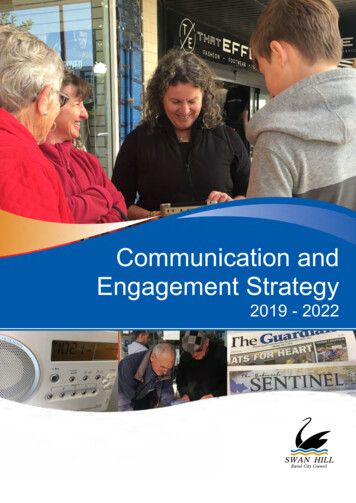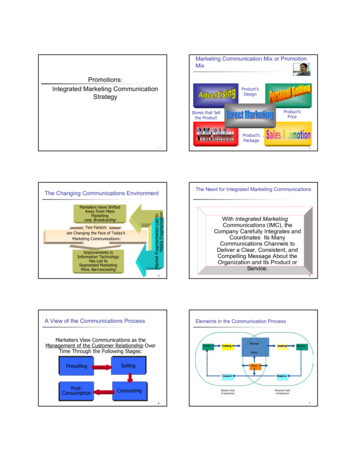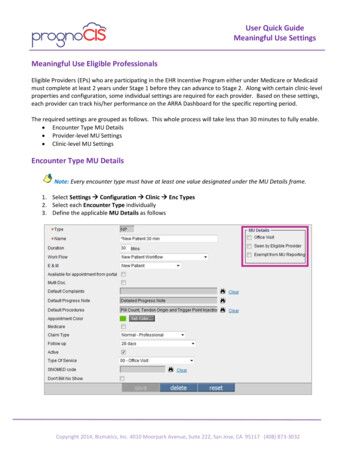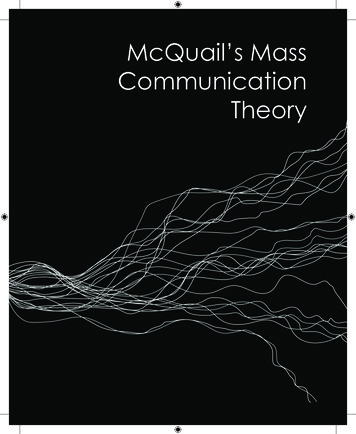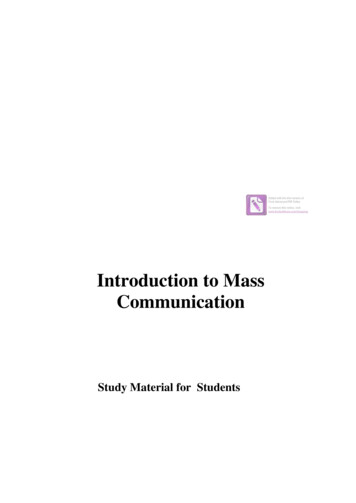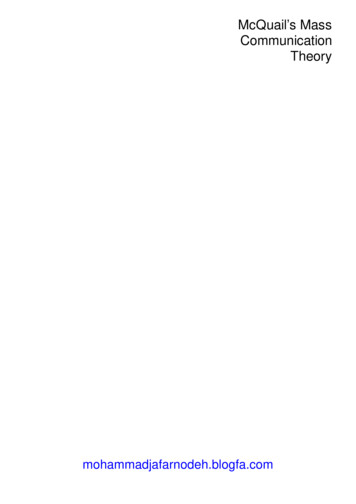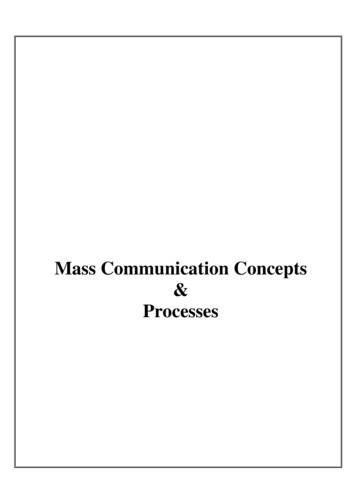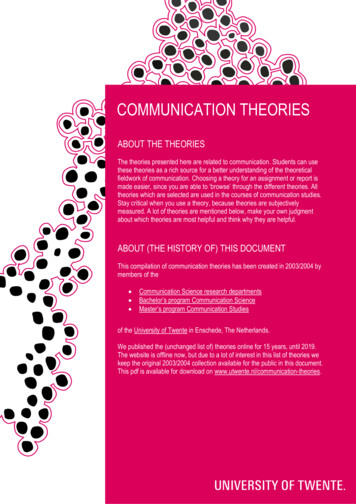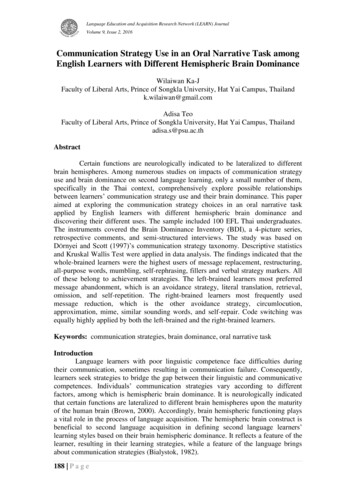
Transcription
Language Education and Acquisition Research Network (LEARN) JournalVolume 9, Issue 2, 2016Communication Strategy Use in an Oral Narrative Task amongEnglish Learners with Different Hemispheric Brain DominanceWilaiwan Ka-JFaculty of Liberal Arts, Prince of Songkla University, Hat Yai Campus, Thailandk.wilaiwan@gmail.comAdisa TeoFaculty of Liberal Arts, Prince of Songkla University, Hat Yai Campus, Thailandadisa.s@psu.ac.thAbstractCertain functions are neurologically indicated to be lateralized to differentbrain hemispheres. Among numerous studies on impacts of communication strategyuse and brain dominance on second language learning, only a small number of them,specifically in the Thai context, comprehensively explore possible relationshipsbetween learners’ communication strategy use and their brain dominance. This paperaimed at exploring the communication strategy choices in an oral narrative taskapplied by English learners with different hemispheric brain dominance anddiscovering their different uses. The sample included 100 EFL Thai undergraduates.The instruments covered the Brain Dominance Inventory (BDI), a 4-picture series,retrospective comments, and semi-structured interviews. The study was based onDÖrnyei and Scott (1997)’s communication strategy taxonomy. Descriptive statisticsand Kruskal Wallis Test were applied in data analysis. The findings indicated that thewhole-brained learners were the highest users of message replacement, restructuring,all-purpose words, mumbling, self-rephrasing, fillers and verbal strategy markers. Allof these belong to achievement strategies. The left-brained learners most preferredmessage abandonment, which is an avoidance strategy, literal translation, retrieval,omission, and self-repetition. The right-brained learners most frequently usedmessage reduction, which is the other avoidance strategy, circumlocution,approximation, mime, similar sounding words, and self-repair. Code switching wasequally highly applied by both the left-brained and the right-brained learners.Keywords: communication strategies, brain dominance, oral narrative taskIntroductionLanguage learners with poor linguistic competence face difficulties duringtheir communication, sometimes resulting in communication failure. Consequently,learners seek strategies to bridge the gap between their linguistic and communicativecompetences. Individuals’ communication strategies vary according to differentfactors, among which is hemispheric brain dominance. It is neurologically indicatedthat certain functions are lateralized to different brain hemispheres upon the maturityof the human brain (Brown, 2000). Accordingly, brain hemispheric functioning playsa vital role in the process of language acquisition. The hemispheric brain construct isbeneficial to second language acquisition in defining second language learners’learning styles based on their brain hemispheric dominance. It reflects a feature of thelearner, resulting in their learning strategies, while a feature of the language bringsabout communication strategies (Bialystok, 1982).188 P a g e
Language Education and Acquisition Research Network (LEARN) JournalVolume 9, Issue 2, 2016Communication strategies relate to cognitive processes presented in differentcommunication strategy taxonomies, specifically those which are based on thecognitive approach placed within a psycholinguistic framework. Among them areFærch and Kasper’s (1983) speech model covering two phases: a planning phase andan execution phase, and Kellerman and Bialystok’s (1997) model of languageproficiency consisting of two processing components: analysis of knowledge andcontrol of processing. Brain hemispheric functioning, accordingly, seems to affect thelearner’s communication strategy use. This assumption was the impetus for a largernumber of studies on the relationship between language learners’ brain hemisphericdominance and their communication strategy use.Literature reviewDefinitions and classifications of communication strategiesFirst raised by Selinker (1972), communication strategy (CS) is a component ofcommunicative competence (DÖrnyei & Thurrel, 1991). Many prominent researchersdefine CS differently according to their perspectives. In the traditional perspective,Tarone (1977), Færch and Kasper (1983), Ellis (1997) and Saville-Troike (2006)define CS as a communicative device applied when trying to overcome linguisticdeficiency in the second language (L2) in order to reach a particular communicativegoal. A few years later Tarone introduced a broader definition in the interactionalperspective where CS is considered as a tool for interlocutors used in jointlynegotiating meaning (DÖrnyei & Scott, 1997). Brown (2000) suggests CS based onthe perspective of error resources for he views it as the process of interlingual transfer.From the extended perspective, DÖrnyei and Scott (1997) extend previous CSdefinitions by including “every potentially intentional attempt to cope with anylanguage-related problem of which the speaker is aware during the course ofcommunication (p.179)”. Reviewing nine different CS taxonomies, DÖrnyei and Scott(1997) discover many similarities in spite of significantly varied terminologies andspecificity levels. For example, “reduction strategies” (Varadi, 1973; Færch & Kasper,1983), “avoidance strategies” (Tarone, 1977), and “message adjustment strategies”(Corder, 1981) share the common aim of preparing one’s message based on one’sresources by changing, reducing or leaving the original content (all cited in DÖrnyeiand Scott, 1997). They suggest their updated taxonomies which integrate their firstfour classifications communication problems (resource deficit, processing timepressure, own performance of problems, and other performance problems) with threebasic categories (direct, indirect, and interactional strategies). Accordingly, in theirlatest taxonomies, each subcategory includes the same four types of communicationproblems with different subtypes. As this study focuses on learners’ one-wayproductive communication strategies used in an oral narrative task, interactionalstrategies are excluded from the discussion in this part.A. Direct strategiesLearners, with deficiency in their communicative resources, might use varioustypes of problem-solving strategies including message abandonment, messagereduction, message replacement, circumlocution, approximation, use of all-purposewords, word-coinage, restructuring, literal translation, foreignizing, code switching,use of similar sounding words, mumbling, omission, retrieval and mime. They mightadopt the means of either self-rephrasing or self-repair on their own performance189 P a g e
Language Education and Acquisition Research Network (LEARN) JournalVolume 9, Issue 2, 2016problems. Most traditional communication strategies are found in this category.B. Indirect strategiesTo process time pressure, learners might use fillers or repeat what they utter.Aware of their own performance problems, they can use verbal strategy markers.Indirect strategies focus on facilitation of conveyance of meaning directly to preventcommunication breakdowns, rather than providing alternative expressions of intendedmeanings.Hemispheric dominance and learning of EnglishBrain hemispheric dominance refers to different functioning of left and rightcerebrals which significantly affects learning style and strategies (Brown, 2000). Lefthemispheric dominant learners are field-independent, with logical and analyticalthoughts, preference of talking, writing, multiple-choice tests, logical problemsolving, and planned and structured processing information. They are good atmathematics, controlling feelings and remembering names, and poor at interpretingbody language with rare use of metaphors. In contrast, right-brained learners are fielddependent, processing holistic, integrative and emotional information. With goodsynthesis, they prefer open-ended questions and intuitive problem solving. They aregood at interpreting body languages and remembering faces. They can learn moreefficiently through demonstration. Previous studies discover significant relationsbetween brain hemispheric dominance and achievements in learning of English. Oflaz(2011) and Ashraf et al. (2014) are consistent as they find that left-brained learnersperform well in their reading comprehension because they are good at applying logicto solve problems. On the other hand, learners with right brain dominancesuccessfully achieve in vocabulary and writing tests due to their excellent response todemonstrations and responses (Oflaz, 2011). In agreement with the previous study,Weisi and Khaksar (2015), who investigated relationships between Iranian EFLlearners’ brain hemispheric dominance and their creativity in EFL writing, discoveredthat the right-brained learners could perform better. According to Mireskandari andAlavi (2015), language learners with different brain hemispheric dominance were notsignificantly different in their spoken communication strategies. However, significantdifference was discovered in their use of specific compensatory of speaking strategies,that is, whole-brained learners applied compensatory communication strategydifferently from left-brained and right-brained ones.Task types and communication strategy useA learning task is basically defined as a classroom activity with goal orientation(Ellis, 2003; Nunan, 2006; Oxford, 2006), involving learners’ comprehension,production, and interaction in the target language (Towndrow, 2007). It encourageslearners to use the target language with a more focus on the conveying of meaningrather than on the practice of form (Ellis, 2003; Nunan, 2006). Task-based learningactivity can improve learners’ language proficiency, specifically their speaking skills(Lochana & Deb, 2006 cited in Rohani, 2011). It also promotes learners’ greater useof positive communication strategies, with less use of reduction and abandonmentstrategies which are considered negative (Rohani, 2011). Ghout-Khenoune (2012)discovers that learners try to use the target language more frequently in communicativetasks: writing and speaking, rather than retrieving communication strategies rooted intheir learned language. It is additionally found that learners’ communication strategiesvary with each different task. They apply more interlingual-based strategies than190 P a g e
Language Education and Acquisition Research Network (LEARN) JournalVolume 9, Issue 2, 2016L1/L2-based strategies in their picture description task (Ghout-Khenoune, 2012).Among studies on EFL learners’ oral communication strategies, hemisphericbrain dominance has been rarely taken into consideration. In addition, investigationsof communication strategies through oral narrative tasks, which are more authenticthan questionnaires, have been scarcely conducted. Specifically, these topics havenever been studied among Thai EFL participants whose mother tongue is PattaniMalay, a Malay dialect, some words of which are similar to English. To fill thesegaps, the present study aimed to explore communication strategies applied by ThaiEFL learners with different brain hemispheric dominance in an oral narrative task.Findings will promote more understanding of differences in learners’ communicationstrategy use possibly resulting from different hemispheric brain patterns. Thiscomprehension could later initiate more varieties of learning activities promotinglearners’ more effective oral communication strategies.Research questionsBased on the above purpose of the study, the following questions were raised:1. What communication strategies are used by left-brained, right-brained andwhole-brained English learners in an oral narrative task?2. Are there any differences in communication strategies used by Englishlearners with different hemispheric brain dominance in an oral narrative task? If so,how and to what extent?MethodologyParticipantsOf a population of 134 third and fourth-year Thai EFL undergraduates, ofacademic year 2015, majoring in English at a private university in southern Thailand,100 students were drawn and stratified by brain hemispheric dominance. Theiraverage language proficiency was at the elementary level (A2) based on their scoresof the Oxford’s Quick Placement Test. The majority of them were Pattani-Malaynative speakers residing in the three southernmost provinces of Thailand, while asmaller number was from the other provinces of the country speaking Thai as theirmother tongue.InstrumentationIn the present study, data were collected by using (1) the Brain DominanceInventory (BDI), (2) a four-picture series, (3) retrospective comments, (4) semistructured interviews, and (5) DÖrnyei and Scott (1997)’s communication taxonomy.The Brain Dominance Inventory (BDI), widely used and accepted in previousstudies on brain hemispheric dominance (Dulger, 2012; Kok, 2013; Mireskandari &Alavi, 2015), was a modified version of Davis et al. (1994) which was originally inEnglish and translated into Thai to avoid participants’ misunderstanding ormisconception of the items in the survey. The inventory including 39 items with threeoptions each was used to determine if the respondent was primarily left-brain, rightbrain, or bi-lateral dominant.A narrative task material was a free-copyrighted four-picture series presentedin the correct order and formed a coherent storyline. The pictures depicted a man, awoman, a baby in a baby carriage and a cow eating grass. The setting was at the191 P a g e
Language Education and Acquisition Research Network (LEARN) JournalVolume 9, Issue 2, 2016backyard of a house. The man was asked by the woman to bottle feed the baby. Themilk was up and the baby needed more milk so the man solved the problem byattaching a rubber tube to the cow breast. The fourth picture presented a humoroussense.For more in-depth investigation of the phenomenon of the participants’communication strategy use in an oral narrative t
Task types and communication strategy use A learning task is basically defined as a classroom activity with goal orientation (Ellis, 2003; Nunan, 2006; Oxford, 2006), involving learners’ comprehension, production, and interaction in the target language (Towndrow, 2007). It encourages learners to use the target language with a more focus on the conveying of meaning rather than on the practice .


